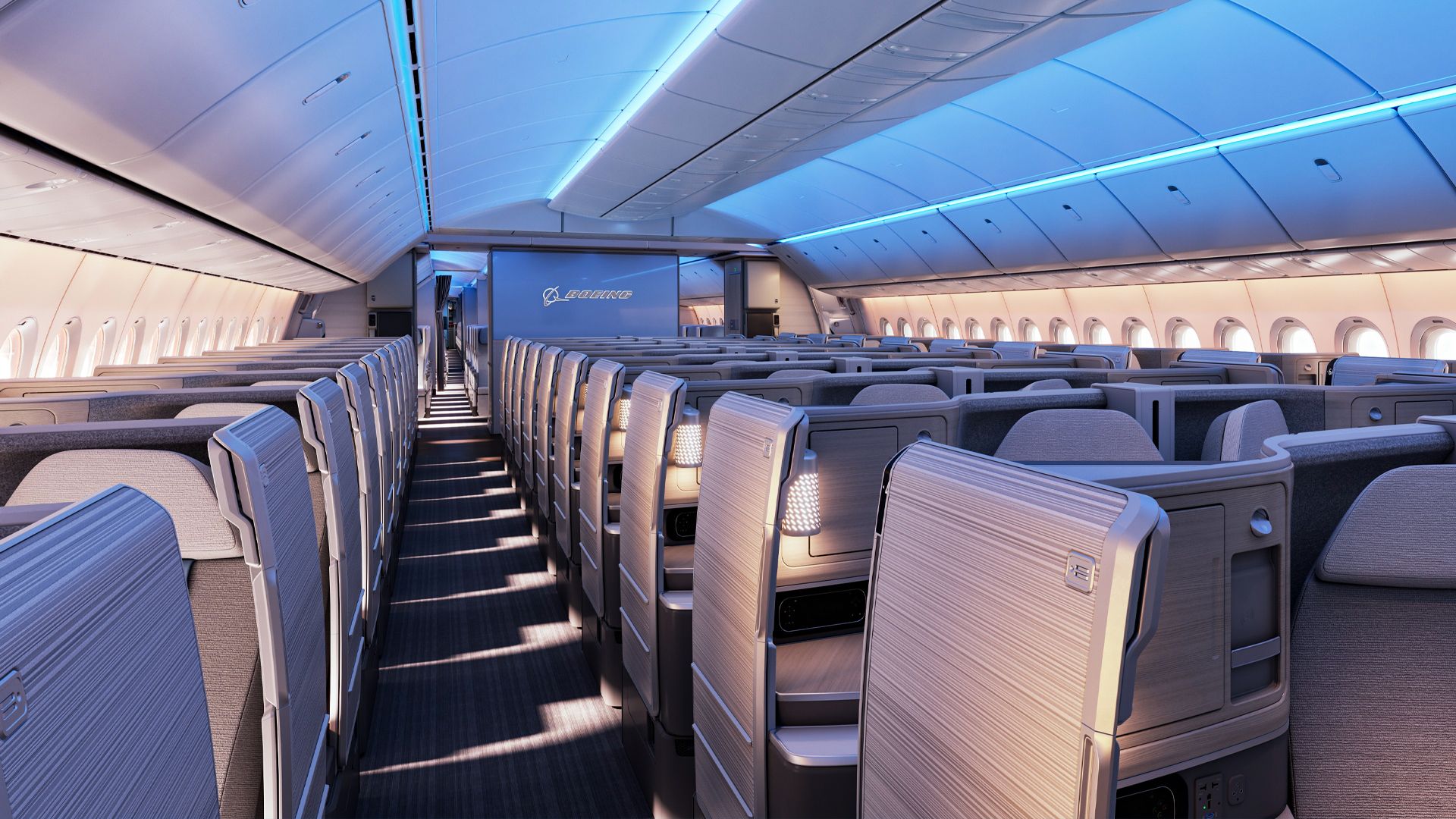The Boeing 777X is poised to transform long-haul air travel with its anticipated entry into commercial service in 2027. This next-generation aircraft features groundbreaking design elements, including the largest commercial aircraft engine ever constructed and innovative folding wingtips. Alongside these advancements, the cabin design promises an enhanced passenger experience, setting a new standard in the aviation industry.
Revolutionary Cabin Features
The cabin of the Boeing 777X incorporates the renowned Boeing Sky Interior, developed in collaboration with design agency Teague. This design aims to create a more spacious and calming atmosphere for passengers. A standout feature is the advanced LED lighting system, which allows airlines to customize the lighting’s color and intensity during flights. For instance, warm tones can enhance meal services, while soft sunrise shades help passengers ease into wakefulness before landing. Such thoughtful design not only elevates the onboard experience but may also contribute to reducing jet lag on long routes.
Boeing has significantly redesigned the overhead lockers, making them larger and more functional. These pivoting lockers are crafted to hold more carry-on luggage while enhancing the sense of headroom for passengers. When closed, they seamlessly blend into the cabin ceiling, contributing to a more open and aesthetically pleasing environment. Another notable aspect is the reimagined windows, which appear larger and allow more natural light into the cabin, further enriching the passenger experience.
Enhanced Space and Flexibility
The Boeing 777X boasts a fuselage width of 19 feet and 7 inches (5.97 meters), which is 4 inches (10 cm) wider than its predecessor, the Boeing 777-300ER. This increase is made possible through the use of advanced materials that allow for thinner cabin walls and a concave interior design. The added space enables airlines to accommodate ten seats abreast in a 3-4-3 configuration, providing an 18-inch seat width that exceeds current industry standards.
A key innovation of the 777X is its modular framework, which permits airlines to customize cabin layouts more efficiently than ever. According to Teague, the design agency involved, the aircraft features two baseline architectural layouts along with customizable lighting and interior segments. This modularity allows airlines to adapt quickly to evolving market demands, such as adjusting the balance between business and economy class.
The structure also simplifies maintenance and reduces weight by segregating systems like lighting and ventilation into different modules. This means that airlines can update interiors with newer products without the need for extensive overhauls.
The Boeing 777X combines advanced technologies with passenger comfort, making it a flagship model in Boeing’s long-haul aircraft lineup. At the heart of its performance are the General Electric GE9X engines, recognized as the largest and most powerful commercial aircraft engines available. These engines, paired with the aircraft’s new composite wings, which feature folding wingtips, contribute to remarkable fuel savings of up to 10% compared to earlier models.
One of the most distinctive features of the 777X is its folding wingtips, which extend the wingspan to an impressive 235 feet (71.63 meters) in flight. This design enhances aerodynamic efficiency while allowing the aircraft to maintain compatibility with existing airport gate infrastructure. Upon landing, the outer 11 feet (3.35 meters) of each wing folds upward, reducing the wingspan to 212 feet (64.62 meters), similar to the 777-300ER.
This innovative wing design has been meticulously crafted to ensure safety, with systems in place to prevent folding during flight. Continuous monitoring by sensors during taxi and takeoff further enhances operational safety.
Challenges and Future Prospects
Despite its impressive attributes, the Boeing 777X program has encountered significant delays, pushing back its launch by more than seven years. Originally slated for delivery in 2020, the aircraft has faced challenges including certification requirements, design modifications, and disruptions caused by the COVID-19 pandemic.
In light of scrutiny following two tragic crashes involving the 737 MAX, the Federal Aviation Administration mandated more rigorous testing and documentation for the 777X. This cautious approach has led to a more methodical development timeline.
As production resumes, test flights have continued, with the first delivery now expected to occur in 2027 to launch customer Lufthansa. Airlines have expressed frustration regarding ongoing delays, which have come against a backdrop of shifting travel patterns and financial pressures in the aviation sector.
Currently, the Boeing 777X has garnered over 500 orders from various airlines worldwide. Emirates is set to become the largest operator of the aircraft, with a total of 205 orders (35 for the 777-8 and 170 for the 777-9). Following Emirates, Qatar Airways has ordered 90 units, while Korean Air has secured 40.
The substantial interest in the Boeing 777X underscores its potential to reshape long-haul travel and solidify Boeing’s legacy of innovation within the aviation industry. As airlines await the arrival of this state-of-the-art aircraft, the anticipation continues to grow for what the future holds in air travel.







